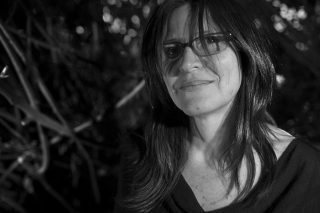English translation below.
SuBastian nos abrió paso en la oscuridad. Una medusa y otros seres saludaron en el camino. En las orillas de la cuenca Cerralvo, en el límite de la corteza continental, bajamos con SuBastian hasta iluminar el fondo marino. Navegamos por el escarpe. La pendiente era ligera y estaba cubierta de sedimento. Buscamos una piedra, un fragmento, pero solo veíamos sedimento y uno que otro pequeño ser. Las posibilidades eran pocas, pero en el science room las miradas sostenían la esperanza. De pronto, ahí estaban, un pequeño grupo de piedras haciendo casa a una diversidad de seres marinos. SuBastian tomó una de ellas, la sacudió ligeramente, haciendo a manera de despedida una estela de sedimento.
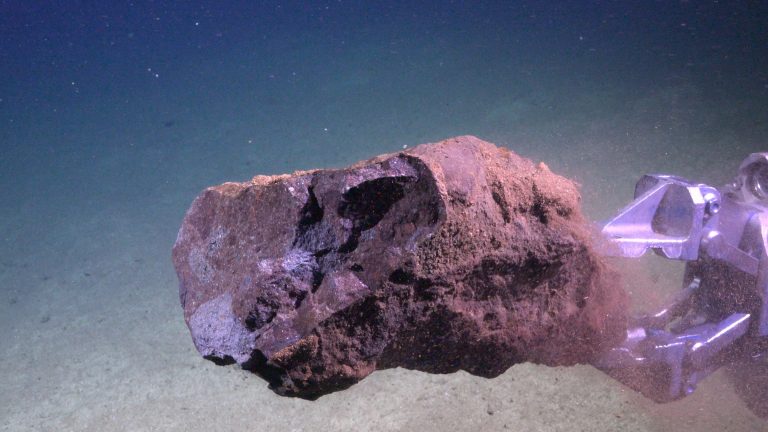 Unas horas después la piedra dejó de ser piedra. Ahora, es una roca. (La clasificación aún está por confirmarse). Es una roca pesada, más o menos del tamaño de una sandía. Tiene muchas gamas de colores verdes, negros, naranjas, blancos… textura foliada, grietas y otros accidentes.
Unas horas después la piedra dejó de ser piedra. Ahora, es una roca. (La clasificación aún está por confirmarse). Es una roca pesada, más o menos del tamaño de una sandía. Tiene muchas gamas de colores verdes, negros, naranjas, blancos… textura foliada, grietas y otros accidentes.
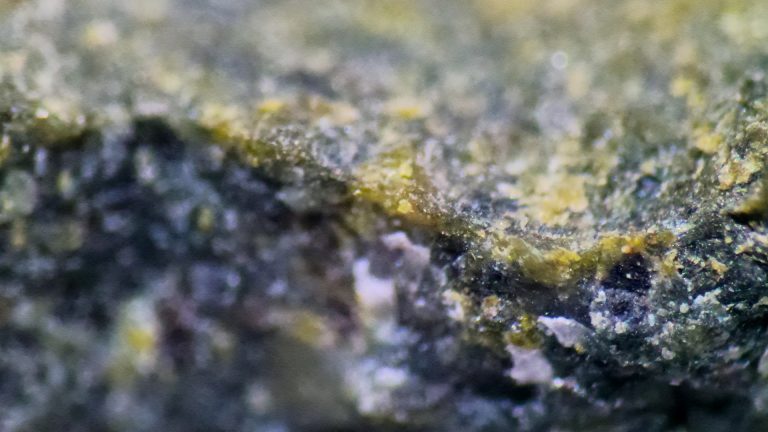
Los científicos a bordo, conversaron con ella en un diálogo a través del tacto. Le acariciaron cada centímetro descubriendo sus secretos. Invité a cada uno de la tripulación a conversar con la roca, a tocarla, a darle la bienvenida al aire, su nuevo hábitat después de estar millones de años bajo el agua. Así, cada uno tocó la roca, cada quien en su lenguaje, a su manera, solo los chefs la olfatearon. Nuestras manos tocaron el fondo marino, pusimos las yemas de nuestros dedos sobre el límite de la corteza continental, sobre la herida de un tiempo geológico, cuando las costas de la península de Baja California y las costas de Sinaloa y Sonora eran un mismo cuerpo.
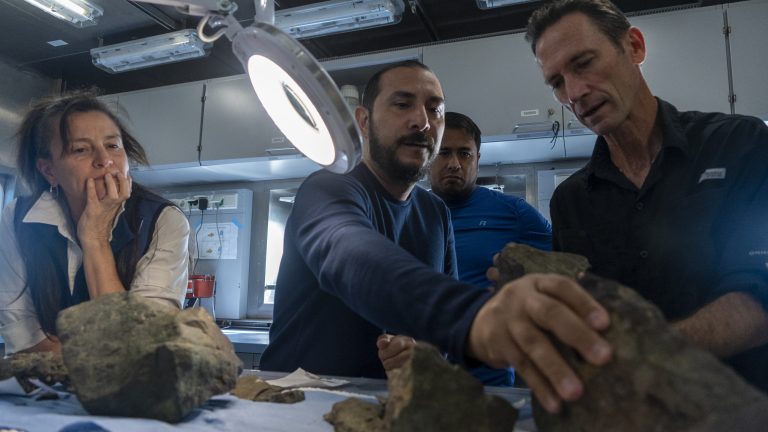 Nos adentramos al Golfo de California con la piedra a bordo. Navegamos norte-sur, vuelta en U, sur-norte, vuelta en U, norte-sur, vuelta en U, sur-norte, … en un movimiento continuo. R/V Falkor también iba tocando suavemente el fondo marino con su eco-sonda multi-haz y así, lentamente su camino dibujaba las formas de la oscuridad. Un dibujo de 15,650 km2, Navegamos más de 1,888 millas náuticas (más o menos 3,500 km lineales) a una velocidad de unos 8 nudos (cerca de 15 km/ hora). Obtuvimos datos, muchos datos, sobre las distancias, las profundidades, la ubicación de columnas de burbujas que indican posibles chimeneas hidrotermales, datos que serán procesados, para hacer un mapa de las profundidades del suelo marino.
Nos adentramos al Golfo de California con la piedra a bordo. Navegamos norte-sur, vuelta en U, sur-norte, vuelta en U, norte-sur, vuelta en U, sur-norte, … en un movimiento continuo. R/V Falkor también iba tocando suavemente el fondo marino con su eco-sonda multi-haz y así, lentamente su camino dibujaba las formas de la oscuridad. Un dibujo de 15,650 km2, Navegamos más de 1,888 millas náuticas (más o menos 3,500 km lineales) a una velocidad de unos 8 nudos (cerca de 15 km/ hora). Obtuvimos datos, muchos datos, sobre las distancias, las profundidades, la ubicación de columnas de burbujas que indican posibles chimeneas hidrotermales, datos que serán procesados, para hacer un mapa de las profundidades del suelo marino.
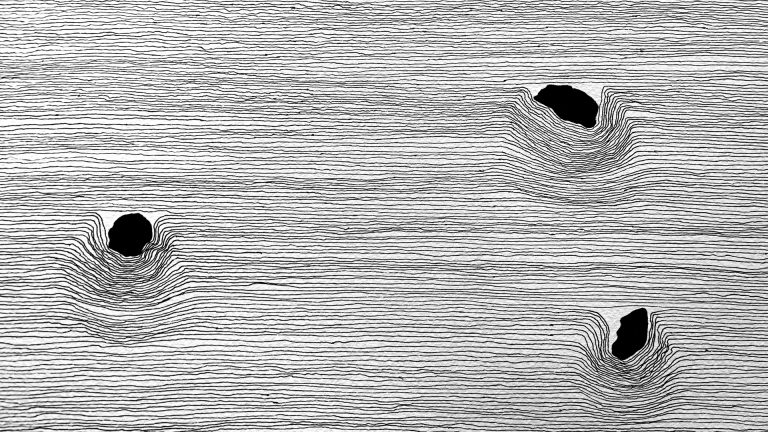
Me atrevo a decir que ésta es una tarea que requiere más esfuerzo que el que se necesitó para hacer la selenografía, el mapa de la superficie lunar que está completamente mapeada con detalle. Y del fondo marino tenemos una batimetría detallada a la fecha de menos del 19%.
En esta etapa de la expedición el R/V Falkor concluyó una batimetría a detalle de casi el 9% del área del Golfo de California, y casi un .0105% del área del todos los océanos en la tierra.
y la roca es un pequeñísimo fragmento,
La estela que deja un barco al navegar se diluye en segundos, pero a través de la batimetría su ruta deja una huella en la construcción del conocimiento.
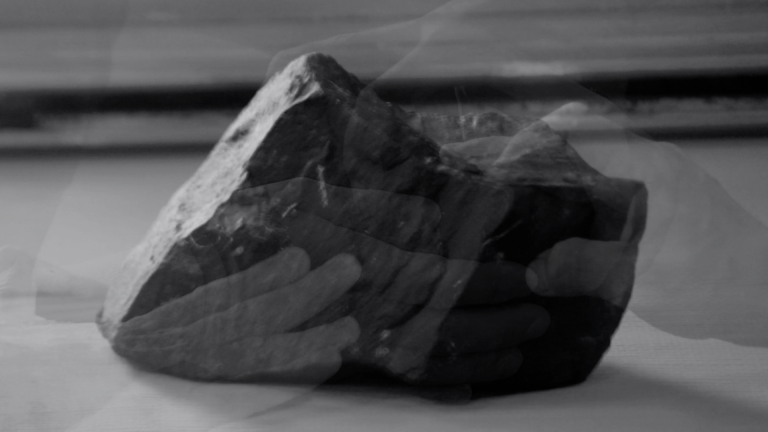
Touch and Draw
SuBastian made way for us in the dark. A jellyfish and other beings greeted on the way. On the shores of the Cerralvo basin, at the limit of the continental crust, we went down with SuBastian until the seabed was illuminated. We sail through the scarp. The slope was slight and covered in sediment. We looked for a stone, a fragment, but only saw sediment and the occasional tiny beings. The chances were few, but in the science room, the eyes held hope. Suddenly, there they were, a small group of stones making home to a diversity of marine beings. SuBastian took one of them, shook it slightly, saying goodbye with a sediment trail.

A few hours later, the stone ceased to be a stone. Now, it is a rock. (The classification is yet to be confirmed). It is a heavy rock, about the size of a watermelon. It has many green, black, orange, white, and other colors … it has a foliated texture, cracks, and other accidents.

The scientists on board conversed with the rock in a dialogue through touch. They caressed every inch of it, discovering its secrets. I invited the crew to talk with the rock, touch it, and welcome it into the air, its new habitat after millions of years underwater. Thus, each one touched the rock, each one in their own language, in their own way, only the chefs smelled it. Our hands touched the seabed, we put our fingertips on the limit of the continental crust, on the wound of a geological time when the coasts of the Baja California peninsula and the shores of Sinaloa and Sonora were the same body.
 We enter the Gulf of California with the stone on board. We sail north-south, U-turn, south-north, U-turn, north-south, U-turn, south-north,… in one continuous movement. R / V Falkor was also gently touching the seabed with its multi-beam echo-sounder, and thus, its path slowly drew the shapes of the darkness. In a drawing of 15,650 km2, we sailed more than 1,888 nautical miles (more or less 3,500 linear km) at a speed of about 8 knots (about 15 km/hour). We obtained data, a lot of data, about the distances, the depths, the location of bubble columns that indicate possible hydrothermal vents, data that will be processed to make a map of the depths of the seafloor.
We enter the Gulf of California with the stone on board. We sail north-south, U-turn, south-north, U-turn, north-south, U-turn, south-north,… in one continuous movement. R / V Falkor was also gently touching the seabed with its multi-beam echo-sounder, and thus, its path slowly drew the shapes of the darkness. In a drawing of 15,650 km2, we sailed more than 1,888 nautical miles (more or less 3,500 linear km) at a speed of about 8 knots (about 15 km/hour). We obtained data, a lot of data, about the distances, the depths, the location of bubble columns that indicate possible hydrothermal vents, data that will be processed to make a map of the depths of the seafloor.

I daresay that this task requires more effort than what was needed to do the selenography, the map of the lunar surface that is fully mapped in detail and high resolution. While here, of the seabed, we have a detailed bathymetry to date of less than 19%.
During this expedition leg, the R / V Falkor completed a detailed bathymetry of almost 9% of the area of the Gulf of California and nearly .0105% of the area of all the oceans on Earth.
and the rock is a tiny fragment,
The ship’s wake is dissolved in seconds, but (through bathymetry) its route leaves a mark on the construction of knowledge.

